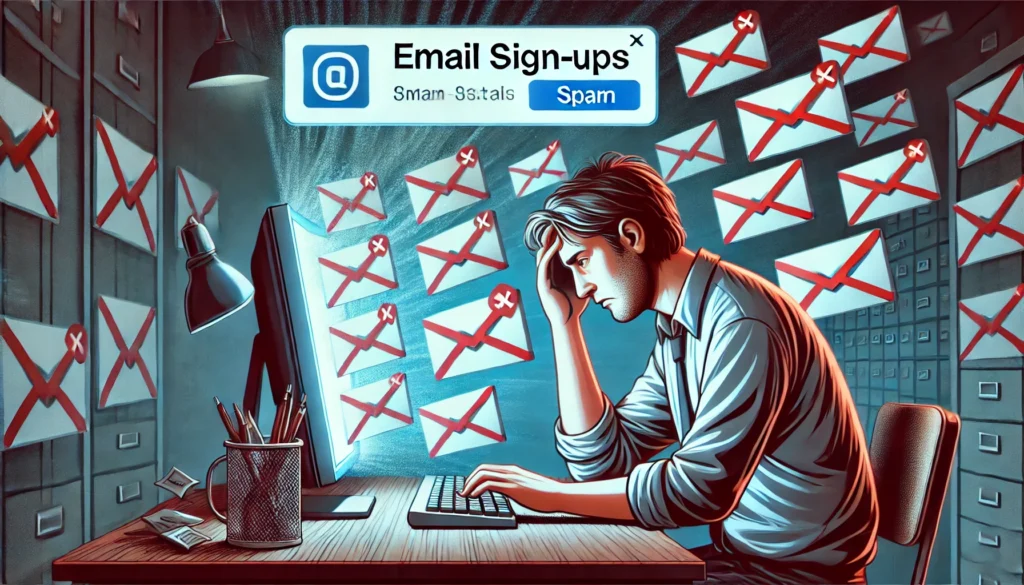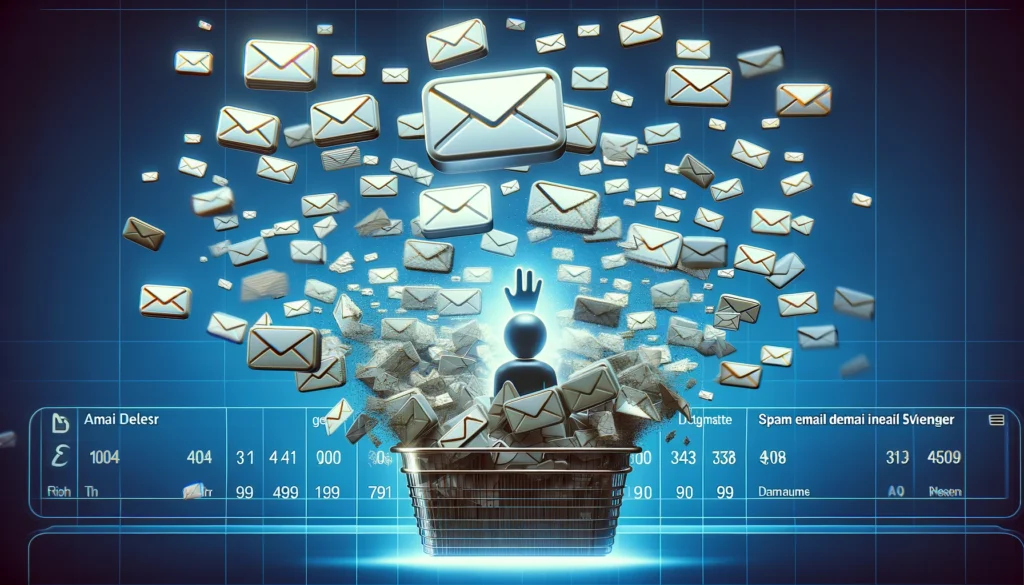Spam email sign-ups occur when bots or individuals use fake or malicious email addresses to subscribe to newsletters, services, or products. This practice can overwhelm inboxes with unwanted messages, cluttering them and making it difficult to discern important communications from junk.
You may also like: Top Email Deleters for Inbox Management
The Mechanics Behind Spam Emails
Spam emails are typically generated through automated scripts and bots that crawl the internet, signing up for email lists indiscriminately. These scripts can mimic human behavior to bypass basic protections and create accounts or subscriptions en masse. As they infiltrate email lists, they flood inboxes with irrelevant content, which can easily lead to important emails being overlooked or lost. Understanding these mechanics is crucial for developing effective countermeasures against spam infiltration.
The Historical Context of Spam
The concept of spam dates back to the early days of the internet. Initially, spam was not considered a significant issue until it became a widespread nuisance in the late 1990s and early 2000s. This period saw a dramatic increase in unsolicited emails, prompting the development of rudimentary spam filters. Over time, spam techniques have evolved, becoming more sophisticated and challenging, necessitating the development of increasingly advanced spam filters and preventative measures. This historical evolution underscores the persistent nature of spam and the need for ongoing vigilance.
The Psychology Behind Spam Creation
Understanding why spammers engage in this activity is key to combating it. Many spammers are motivated by financial gain, using spam emails as a means to distribute advertisements or as part of phishing schemes. Others may engage in spamming for malicious purposes, such as spreading malware or conducting identity theft. The psychological underpinnings of spam creation often involve exploiting human vulnerabilities, such as curiosity or fear, which can make spam emails particularly effective if not properly managed.
The Consequences of Spam Email Sign-Ups
The impact of spam email sign-ups extends beyond personal annoyance. Here, we explore how it affects individuals and organizations:
Personal Implications
For individuals, spam emails can lead to several challenges:
- Overloaded Inboxes: An excess of spam emails can make it difficult to manage personal and professional communications efficiently. Individuals may find themselves spending significant time sifting through irrelevant emails to find genuine messages.
- Phishing Risks: Many spam emails are designed to trick recipients into divulging personal information, posing a risk of identity theft and fraud. These emails often masquerade as communications from legitimate entities, making it crucial for individuals to remain vigilant.
- Decreased Productivity: Constantly sorting through and deleting spam emails can be time-consuming and distracting. This can lead to decreased focus on important tasks and a general decline in productivity, particularly for those who rely heavily on email for work.
Business Implications
For businesses, spam email sign-ups can have serious ramifications:
- Resource Drain: Managing spam emails requires IT resources, which could otherwise be used to support business operations. This diversion of resources can impact overall efficiency and effectiveness.
- Data Integrity Issues: Spam sign-ups can skew marketing data, leading to inaccurate insights and ineffective strategies. Businesses may struggle to develop successful marketing campaigns if their data is compromised by spam.
- Brand Damage: If spam emails are sent from a company’s domain, it can harm the brand’s reputation and trustworthiness. This can result in lost customer trust and potential revenue loss, making it imperative for businesses to maintain email security.
The Broader Economic Impact
Spam emails also have a broader economic impact. According to studies, the global cost of spam is estimated to be billions of dollars annually, considering lost productivity, increased IT expenses, and compromised data security. The financial burden extends beyond individual businesses, affecting the economy at large. This economic impact highlights the need for collective action and investment in spam prevention technologies. Furthermore, the cost of data breaches resulting from spam can have long-lasting effects on both businesses and consumers, emphasizing the importance of robust security measures.
How to Combat Spam Email Sign-Ups
Fortunately, there are several strategies individuals and organizations can employ to mitigate the impact of spam email sign-ups:
Implementing Strong Filters
Email providers offer spam filters that can automatically detect and quarantine spam emails. Regularly updating and fine-tuning these filters is crucial for maintaining their effectiveness. Advanced filters utilize algorithms that learn from user behavior, identifying patterns that indicate spam. This adaptive approach helps in keeping up with the ever-evolving tactics of spammers. By ensuring that email filters are always up-to-date, individuals and organizations can reduce the volume of spam that reaches their inboxes significantly.
Utilizing CAPTCHA
Implementing CAPTCHA on sign-up forms can prevent automated bots from subscribing to email lists, reducing the volume of spam sign-ups. CAPTCHAs require users to perform tasks that are easy for humans but difficult for bots, such as identifying images or solving puzzles. By incorporating CAPTCHAs, organizations can create an additional layer of security, deterring automated spam attempts. This simple yet effective measure can help maintain the quality of email lists and protect against spam infiltration.
Educating Users
Educating users about the risks of spam emails and how to recognize phishing attempts can empower them to protect themselves and their organizations. Training programs can teach employees to identify suspicious emails and avoid clicking on potentially harmful links. Regular updates and reminders about best practices can reinforce this knowledge, fostering a culture of security awareness. Empowered and informed users are less likely to fall victim to spam-related threats, enhancing overall organizational security.
Regular Audits
Conducting regular audits of email lists and removing suspicious or inactive email addresses can help maintain the integrity of marketing data. By identifying and eliminating spam entries, businesses can ensure that their communications reach genuine recipients. Audits also provide an opportunity to review and optimize data collection practices, enhancing overall data quality. Regular maintenance of email lists is a proactive approach that can prevent the accumulation of spam over time.
Advanced Authentication Techniques
Beyond basic CAPTCHAs, implementing advanced authentication techniques such as two-factor authentication (2FA) can further secure email sign-up processes. 2FA requires users to verify their identity through a second method, such as a text message or authentication app, adding an extra layer of security. This approach significantly reduces the likelihood of unauthorized access and spam sign-ups. By adopting comprehensive authentication measures, organizations can better safeguard their email lists and protect sensitive data.

Future Implications and Trends
As technology evolves, so do the methods employed by spammers. It is crucial to stay informed about the latest trends in spam email and the strategies used to combat them.
Advances in AI and Machine Learning
AI and machine learning are being used to develop more sophisticated spam filters that can adapt to new spam techniques, offering better protection for users. These technologies analyze vast amounts of data to detect patterns and predict spam behavior, enabling real-time identification and blocking of threats. As AI continues to evolve, its application in spam prevention is expected to become even more effective, providing a robust defense against emerging spam tactics. Investing in AI-driven solutions is a forward-thinking approach that can enhance email security in the long term.
The Role of Legislation
Legislation such as the CAN-SPAM Act in the U.S. and the GDPR in Europe plays a pivotal role in regulating email marketing practices and protecting consumers from spam. These regulations impose strict guidelines on how businesses can collect and use email addresses, promoting transparency and accountability. Compliance with such laws is essential for businesses to avoid legal penalties and maintain consumer trust. As regulatory landscapes continue to change, staying informed about legal requirements is crucial for organizations to align their practices with current standards.

The Ethical Dimension
As we continue to combat spam email sign-ups, it is important to consider the ethical implications of data collection and privacy. Balancing the need for effective marketing with respect for user privacy remains a critical challenge. Ethical considerations involve transparent communication about data usage and obtaining informed consent from users. Organizations must prioritize user privacy, ensuring that their marketing practices do not infringe on individual rights. By fostering ethical standards, businesses can build trust and maintain positive relationships with their audiences.
Emerging Technologies and Their Impact
The rise of new technologies such as blockchain and quantum computing has the potential to revolutionize email security. Blockchain can offer decentralized solutions for verifying email authenticity, while quantum computing could redefine encryption standards. As these technologies develop, their implications for combating spam and enhancing email security are significant. Keeping abreast of technological advancements can provide organizations with innovative tools to address spam challenges effectively.

Conclusion
Spam email sign-ups may seem like a mere inconvenience, but their impact is significant and far-reaching. By understanding the mechanics behind spam, recognizing its implications, and employing effective countermeasures, individuals and businesses can mitigate its impact and protect their digital environments. As we look to the future, staying informed and proactive will be key to navigating the ever-evolving landscape of email communication. Fostering a culture of awareness and resilience will empower organizations and individuals alike to combat spam effectively, ensuring that email remains a reliable and secure channel for communication.
Further Reading:
Subscribe to the Mailing List and keep up to date with news from 2BrightSparks
Fighting Spam Sign Ups: 5 Tactics to Prevent Them
Important Note: The information contained in this article is for general informational purposes only, and should not be construed as health or medical advice, nor is it intended to diagnose, prevent, treat, or cure any disease or health condition. Before embarking on any diet, fitness regimen, or program of nutritional supplementation, it is advisable to consult your healthcare professional in order to determine its safety and probable efficacy in terms of your individual state of health.
Regarding Nutritional Supplements Or Other Non-Prescription Health Products: If any nutritional supplements or other non-prescription health products are mentioned in the foregoing article, any claims or statements made about them have not been evaluated by the U.S. Food and Drug Administration, and such nutritional supplements or other health products are not intended to diagnose, treat, cure, or prevent any disease.


